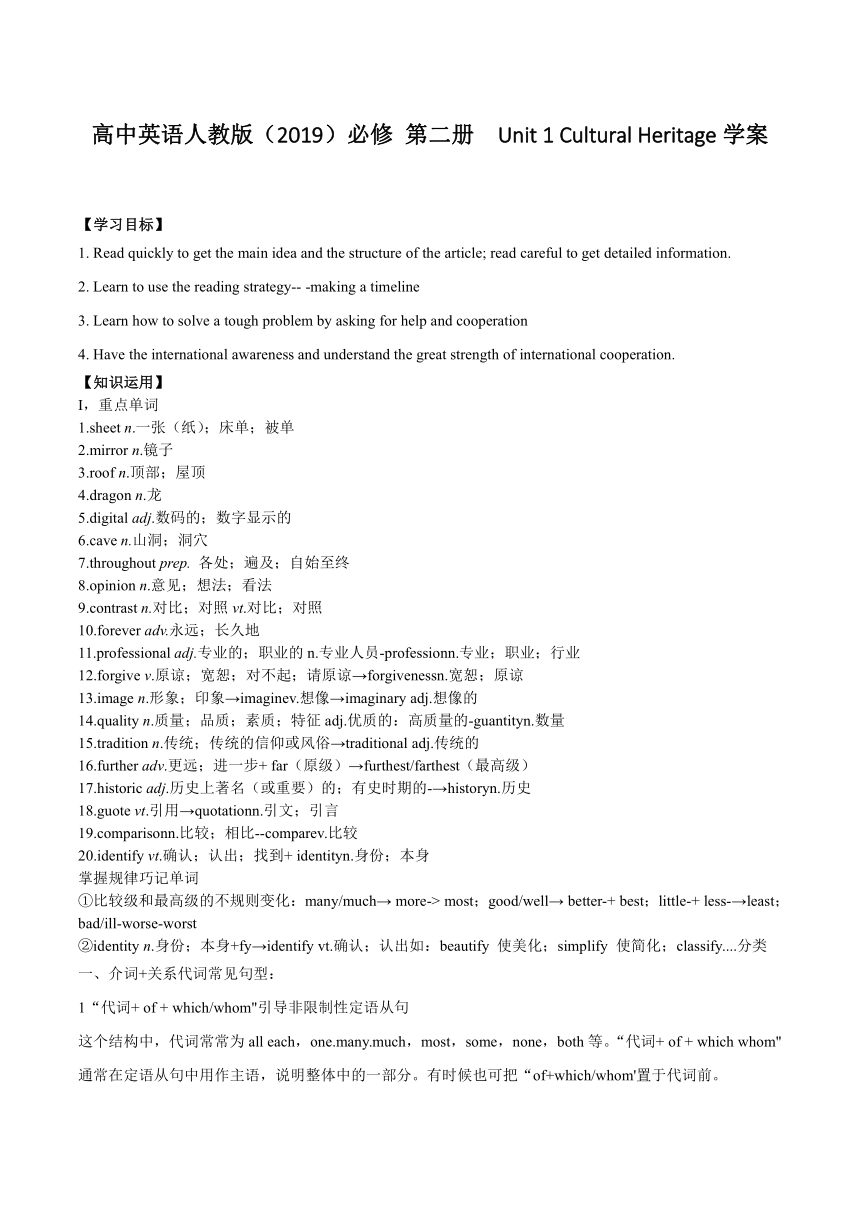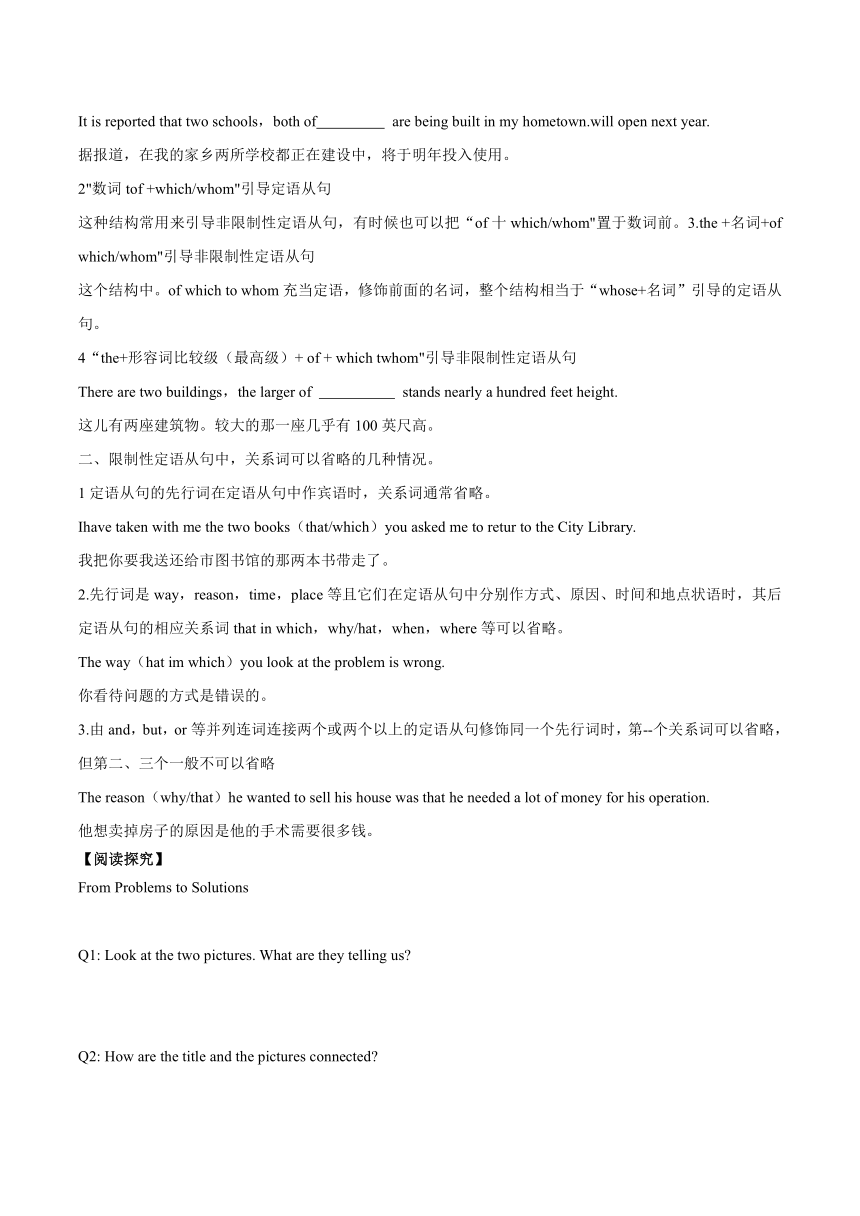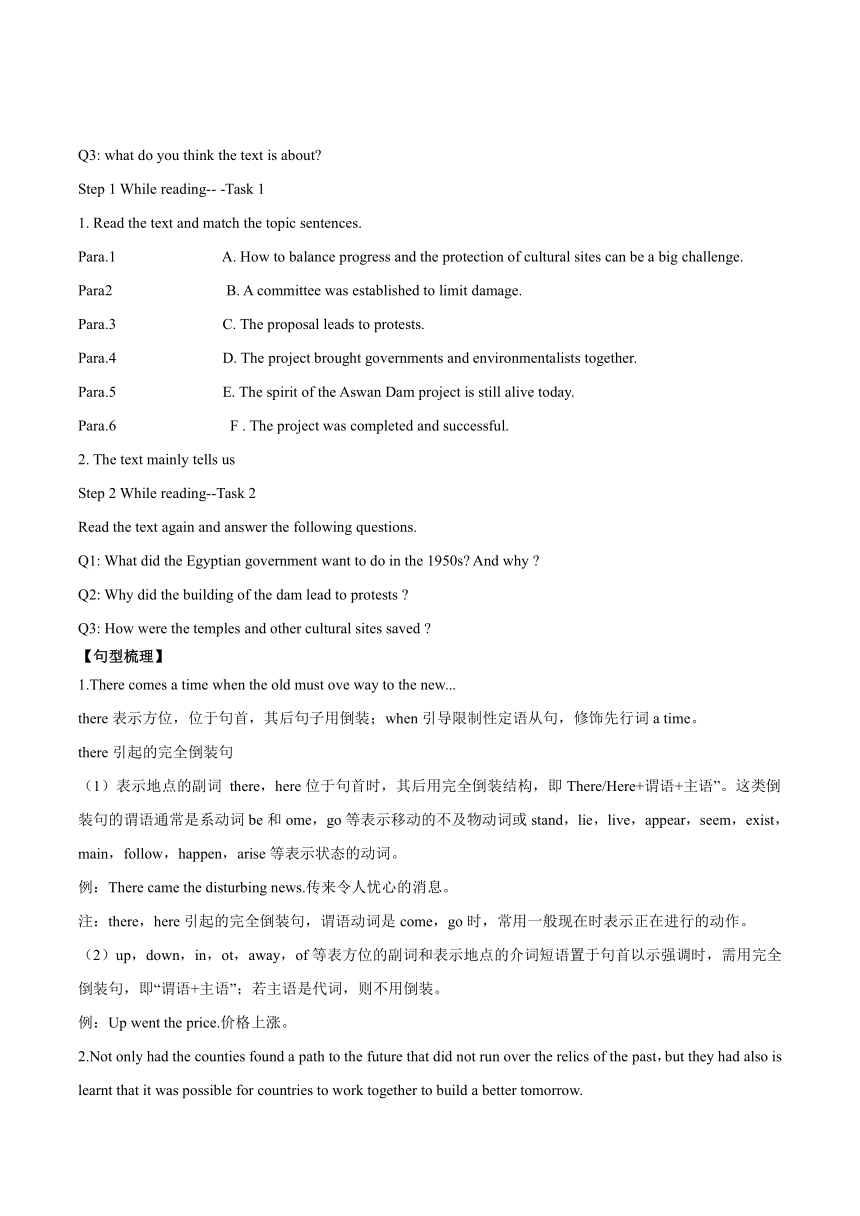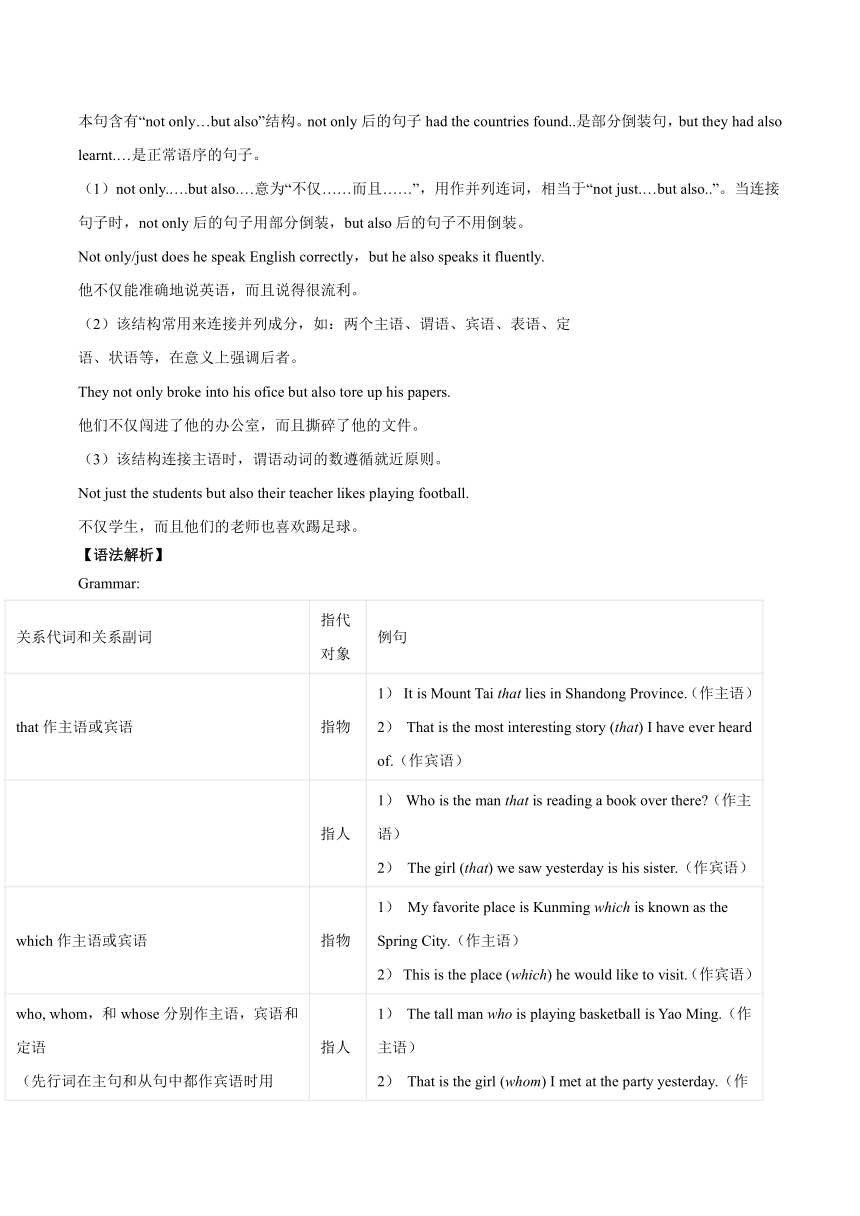人教版(2019)必修 第二册 :Unit 1 Cultural Heritage 知识点学案(无答案)
文档属性
| 名称 | 人教版(2019)必修 第二册 :Unit 1 Cultural Heritage 知识点学案(无答案) |  | |
| 格式 | docx | ||
| 文件大小 | 24.1KB | ||
| 资源类型 | 教案 | ||
| 版本资源 | 人教版(2019) | ||
| 科目 | 英语 | ||
| 更新时间 | 2022-01-18 15:06:57 | ||
图片预览




文档简介
高中英语人教版(2019)必修 第二册 Unit 1 Cultural Heritage学案
【学习目标】
1. Read quickly to get the main idea and the structure of the article; read careful to get detailed information.
2. Learn to use the reading strategy-- -making a timeline
3. Learn how to solve a tough problem by asking for help and cooperation
4. Have the international awareness and understand the great strength of international cooperation.
【知识运用】
I,重点单词
1.sheet n.一张(纸);床单;被单
2.mirror n.镜子
3.roof n.顶部;屋顶
4.dragon n.龙
5.digital adj.数码的;数字显示的
6.cave n.山洞;洞穴
7.throughout prep. 各处;遍及;自始至终
8.opinion n.意见;想法;看法
9.contrast n.对比;对照vt.对比;对照
10.forever adv.永远;长久地
11.professional adj.专业的;职业的n.专业人员-professionn.专业;职业;行业
12.forgive v.原谅;宽恕;对不起;请原谅→forgivenessn.宽恕;原谅
13.image n.形象;印象→imaginev.想像→imaginary adj.想像的
14.quality n.质量;品质;素质;特征adj.优质的:高质量的-guantityn.数量
15.tradition n.传统;传统的信仰或风俗→traditional adj.传统的
16.further adv.更远;进一步+ far(原级)→furthest/farthest(最高级)
17.historic adj.历史上著名(或重要)的;有史时期的-→historyn.历史
18.guote vt.引用→quotationn.引文;引言
parisonn.比较;相比--comparev.比较
20.identify vt.确认;认出;找到+ identityn.身份;本身
掌握规律巧记单词
①比较级和最高级的不规则变化:many/much→ more-> most;good/well→ better-+ best;little-+ less-→least;bad/ill-worse-worst
②identity n.身份;本身+fy→identify vt.确认;认出如:beautify 使美化;simplify 使简化;classify....分类
一、介词+关系代词常见句型:
1“代词+ of + which/whom"引导非限制性定语从句
这个结构中,代词常常为all each,one.many.much,most,some,none,both等。“代词+ of + which whom"
通常在定语从句中用作主语,说明整体中的一部分。有时候也可把“of+which/whom'置于代词前。
It is reported that two schools,both of are being built in my hometown.will open next year.
据报道,在我的家乡两所学校都正在建设中,将于明年投入使用。
2"数词tof +which/whom"引导定语从句
这种结构常用来引导非限制性定语从句,有时候也可以把“of十which/whom"置于数词前。3.the +名词+of which/whom"引导非限制性定语从句
这个结构中。of which to whom充当定语,修饰前面的名词,整个结构相当于“whose+名词”引导的定语从句。
4“the+形容词比较级(最高级)+ of + which twhom"引导非限制性定语从句
There are two buildings,the larger of stands nearly a hundred feet height.
这儿有两座建筑物。较大的那一座几乎有100英尺高。
二、限制性定语从句中,关系词可以省略的几种情况。
1定语从句的先行词在定语从句中作宾语时,关系词通常省略。
Ihave taken with me the two books(that/which)you asked me to retur to the City Library.
我把你要我送还给市图书馆的那两本书带走了。
2.先行词是way,reason,time,place等且它们在定语从句中分别作方式、原因、时间和地点状语时,其后定语从句的相应关系词that in which,why/hat,when,where等可以省略。
The way(hat im which)you look at the problem is wrong.
你看待问题的方式是错误的。
3.由and,but,or等并列连词连接两个或两个以上的定语从句修饰同一个先行词时,第--个关系词可以省略,但第二、三个一般不可以省略
The reason(why/that)he wanted to sell his house was that he needed a lot of money for his operation.
他想卖掉房子的原因是他的手术需要很多钱。
【阅读探究】
From Problems to Solutions
Q1: Look at the two pictures. What are they telling us
Q2: How are the title and the pictures connected
Q3: what do you think the text is about
Step 1 While reading-- -Task 1
1. Read the text and match the topic sentences.
Para.1 A. How to balance progress and the protection of cultural sites can be a big challenge.
Para2 B. A committee was established to limit damage.
Para.3 C. The proposal leads to protests.
Para.4 D. The project brought governments and environmentalists together.
Para.5 E. The spirit of the Aswan Dam project is still alive today.
Para.6 F . The project was completed and successful.
2. The text mainly tells us
Step 2 While reading--Task 2
Read the text again and answer the following questions.
Q1: What did the Egyptian government want to do in the 1950s And why
Q2: Why did the building of the dam lead to protests
Q3: How were the temples and other cultural sites saved
【句型梳理】
1.There comes a time when the old must ove way to the new...
there表示方位,位于句首,其后句子用倒装;when引导限制性定语从句,修饰先行词a time。
there引起的完全倒装句
(1)表示地点的副词 there,here位于句首时,其后用完全倒装结构,即There/Here+谓语+主语”。这类倒装句的谓语通常是系动词be和ome,go等表示移动的不及物动词或stand,lie,live,appear,seem,exist,main,follow,happen,arise等表示状态的动词。
例:There came the disturbing news.传来令人忧心的消息。
注:there,here引起的完全倒装句,谓语动词是come,go时,常用一般现在时表示正在进行的动作。
(2)up,down,in,ot,away,of等表方位的副词和表示地点的介词短语置于句首以示强调时,需用完全倒装句,即“谓语+主语”;若主语是代词,则不用倒装。
例:Up went the price.价格上涨。
2.Not only had the counties found a path to the future that did not run over the relics of the past,but they had also is learnt that it was possible for countries to work together to build a better tomorrow.
本句含有“not only…but also”结构。not only后的句子had the countries found..是部分倒装句,but they had also learnt.…是正常语序的句子。
(1)not only.….but also.…意为“不仅……而且……”,用作并列连词,相当于“not just.…but also..”。当连接句子时,not only后的句子用部分倒装,but also后的句子不用倒装。
Not only/just does he speak English correctly,but he also speaks it fluently.
他不仅能准确地说英语,而且说得很流利。
(2)该结构常用来连接并列成分,如:两个主语、谓语、宾语、表语、定
语、状语等,在意义上强调后者。
They not only broke into his ofice but also tore up his papers.
他们不仅闯进了他的办公室,而且撕碎了他的文件。
(3)该结构连接主语时,谓语动词的数遵循就近原则。
Not just the students but also their teacher likes playing football.
不仅学生,而且他们的老师也喜欢踢足球。
【语法解析】
Grammar:
关系代词和关系副词 指代对象 例句
that作主语或宾语 指物 1) It is Mount Tai that lies in Shandong Province.(作主语) 2) That is the most interesting story (that) I have ever heard of.(作宾语)
指人 1) Who is the man that is reading a book over there (作主语) 2) The girl (that) we saw yesterday is his sister.(作宾语)
which作主语或宾语 指物 1) My favorite place is Kunming which is known as the Spring City.(作主语) 2) This is the place (which) he would like to visit.(作宾语)
who, whom,和whose分别作主语,宾语和定语 (先行词在主句和从句中都作宾语时用whom) 指人 1) The tall man who is playing basketball is Yao Ming.(作主语) 2) That is the girl (whom) I met at the party yesterday.(作宾语) 3) Is this the boy whose parents went to Canada last year.(作定语)
when, where和,why分别作时间状语,地点状语和原因状语 1) I shall never forget the day when we first met in a park.(作时间状语) 2) My favorite city is Beijing where I can visit the Great Wall.(作地点状语) 3) This is the reason why you should leave.(作原因状语)
注:that和which都可指物,且在句中都可作主语和宾语,多数情况下可以互换。但在以下情况中,关系代词只能用that,不能用which。
1.先行词既指人又指物。
2.先行词被all, every, any, little, only, much, no等不定代词修饰时,或先行词本身是all, much, everything, anything, no以及no构成的复合词。
3.先行词被形容词最高级或序数词修饰。
4.先行词被the only, the very, the last, the same修饰。
5.有两个或两个以上分别表示人和物的先行词。
6.主句以who, what, which开头的特殊疑问句。
关系代词和关系副词的判定方法:
关系副词和关系代词的选择是根据先行词在定语从句中做的成分。若是做状语,则用关系副词或“介词+which”; 若是做主语和宾语,则用关系代词。
“介词+关系代词”引导的定语从句:
关系代词做介词的宾语时,为了使关系代词与先行词的关系词更加紧凑,可以将从句中的介词提前到关系代词之前,形成“介词+关系代词”结构。该结构中的关系代词可用which或whom;介词可以依据从句中的谓语的搭配、与先行词的搭配或句子意义来确定。
Is this the car for which you paid a high price
这是你画大价钱买的车吗?(根据从句中谓语动词pay的搭配来定)
注:(1)有些“动词+介词”短语,如 look for, look after, call on等不可拆开而把介词置于关系代词之前。
(2)有时候“介词+关系代词”前还会有名词、代词等。
The river, the bank of which are covered with trees, flows to the seas.
定语从句需要注意的问题:
1. as引导限制性定语从句时,常用于下列句式中:
such+名词+as..…像……一样的;the same+名词+as.…
和……同样的。
2.当先行词是time时,若time表示“次数”,应用that引导定语从句,并且that可以省略;若time表示“一段时间”
讲,应用when或“at/during+which”引导定语从句。
This is the second time(that)the president has visited the country.
这是这位总统第二次访问这个国家。
This is at a time when/during which there were no radios,no telephones or no TV sets.
这是在一个没有收音机,没有电话,也没有电视机的时代。
3.定语从句中的主谓一致
当关系代词在从句中做主语时,从句中谓语动词的数
原则上要与先行词保持一致,但要注意以下几点:先行词是
“one of+复数名词”结构时,关系代词引导的定语从句中的谓语动词一般用复数形式;但如有the very,the only,the first,the last,the right 等修饰one时,谓语动词用单数。
This is one of the most interesting questions that have been asked.
这是被问过的最有意思的问题之一。
4. stage表示“阶段”,occasion表示“场合”,后接的定语从句既可接when也可接where。
The baby has reached the stage when he can stand up.
婴儿到了能站立的阶段了。
【巩固练习】
1.My brother has a wide range of hobbies, _____ _____ playing basketball is his favourite one.
2.I’ve studied happiness and well-being, _____ _____ we now know a great deal.
3.Tom stayed with me for two weeks __________ time we learned music together.
4.Last week we visited the British Museum, which attracted tourists from all _____ the world.
5.The_____ (image) of the moon’s surface were transmitted back to earth and printed out.
6.In contrast _____ my previous impression, the atmosphere here is not tense at all.
7.It is difficult to make a ____________ (compare) with her previous book.
8.Scientists can _____ (identity) trends for the future,but accurate predictions are almost impossible.
9.The environment will be improved by our _____ (far) efforts to reduce pollution.
10.In addition to these _____ (tradition) activities, we have a wider range of choices.
参考答案
1.答案:among which
解析:
2.答案:about which
解析:
3.答案:during which
解析:
4.答案:over
解析:
5.答案:images
解析:
6.答案:with/to
解析:
7.答案:comparison
解析:
8.答案:identify
解析:
9.答案:further
解析:
10.答案:traditional
解析:
【学习目标】
1. Read quickly to get the main idea and the structure of the article; read careful to get detailed information.
2. Learn to use the reading strategy-- -making a timeline
3. Learn how to solve a tough problem by asking for help and cooperation
4. Have the international awareness and understand the great strength of international cooperation.
【知识运用】
I,重点单词
1.sheet n.一张(纸);床单;被单
2.mirror n.镜子
3.roof n.顶部;屋顶
4.dragon n.龙
5.digital adj.数码的;数字显示的
6.cave n.山洞;洞穴
7.throughout prep. 各处;遍及;自始至终
8.opinion n.意见;想法;看法
9.contrast n.对比;对照vt.对比;对照
10.forever adv.永远;长久地
11.professional adj.专业的;职业的n.专业人员-professionn.专业;职业;行业
12.forgive v.原谅;宽恕;对不起;请原谅→forgivenessn.宽恕;原谅
13.image n.形象;印象→imaginev.想像→imaginary adj.想像的
14.quality n.质量;品质;素质;特征adj.优质的:高质量的-guantityn.数量
15.tradition n.传统;传统的信仰或风俗→traditional adj.传统的
16.further adv.更远;进一步+ far(原级)→furthest/farthest(最高级)
17.historic adj.历史上著名(或重要)的;有史时期的-→historyn.历史
18.guote vt.引用→quotationn.引文;引言
parisonn.比较;相比--comparev.比较
20.identify vt.确认;认出;找到+ identityn.身份;本身
掌握规律巧记单词
①比较级和最高级的不规则变化:many/much→ more-> most;good/well→ better-+ best;little-+ less-→least;bad/ill-worse-worst
②identity n.身份;本身+fy→identify vt.确认;认出如:beautify 使美化;simplify 使简化;classify....分类
一、介词+关系代词常见句型:
1“代词+ of + which/whom"引导非限制性定语从句
这个结构中,代词常常为all each,one.many.much,most,some,none,both等。“代词+ of + which whom"
通常在定语从句中用作主语,说明整体中的一部分。有时候也可把“of+which/whom'置于代词前。
It is reported that two schools,both of are being built in my hometown.will open next year.
据报道,在我的家乡两所学校都正在建设中,将于明年投入使用。
2"数词tof +which/whom"引导定语从句
这种结构常用来引导非限制性定语从句,有时候也可以把“of十which/whom"置于数词前。3.the +名词+of which/whom"引导非限制性定语从句
这个结构中。of which to whom充当定语,修饰前面的名词,整个结构相当于“whose+名词”引导的定语从句。
4“the+形容词比较级(最高级)+ of + which twhom"引导非限制性定语从句
There are two buildings,the larger of stands nearly a hundred feet height.
这儿有两座建筑物。较大的那一座几乎有100英尺高。
二、限制性定语从句中,关系词可以省略的几种情况。
1定语从句的先行词在定语从句中作宾语时,关系词通常省略。
Ihave taken with me the two books(that/which)you asked me to retur to the City Library.
我把你要我送还给市图书馆的那两本书带走了。
2.先行词是way,reason,time,place等且它们在定语从句中分别作方式、原因、时间和地点状语时,其后定语从句的相应关系词that in which,why/hat,when,where等可以省略。
The way(hat im which)you look at the problem is wrong.
你看待问题的方式是错误的。
3.由and,but,or等并列连词连接两个或两个以上的定语从句修饰同一个先行词时,第--个关系词可以省略,但第二、三个一般不可以省略
The reason(why/that)he wanted to sell his house was that he needed a lot of money for his operation.
他想卖掉房子的原因是他的手术需要很多钱。
【阅读探究】
From Problems to Solutions
Q1: Look at the two pictures. What are they telling us
Q2: How are the title and the pictures connected
Q3: what do you think the text is about
Step 1 While reading-- -Task 1
1. Read the text and match the topic sentences.
Para.1 A. How to balance progress and the protection of cultural sites can be a big challenge.
Para2 B. A committee was established to limit damage.
Para.3 C. The proposal leads to protests.
Para.4 D. The project brought governments and environmentalists together.
Para.5 E. The spirit of the Aswan Dam project is still alive today.
Para.6 F . The project was completed and successful.
2. The text mainly tells us
Step 2 While reading--Task 2
Read the text again and answer the following questions.
Q1: What did the Egyptian government want to do in the 1950s And why
Q2: Why did the building of the dam lead to protests
Q3: How were the temples and other cultural sites saved
【句型梳理】
1.There comes a time when the old must ove way to the new...
there表示方位,位于句首,其后句子用倒装;when引导限制性定语从句,修饰先行词a time。
there引起的完全倒装句
(1)表示地点的副词 there,here位于句首时,其后用完全倒装结构,即There/Here+谓语+主语”。这类倒装句的谓语通常是系动词be和ome,go等表示移动的不及物动词或stand,lie,live,appear,seem,exist,main,follow,happen,arise等表示状态的动词。
例:There came the disturbing news.传来令人忧心的消息。
注:there,here引起的完全倒装句,谓语动词是come,go时,常用一般现在时表示正在进行的动作。
(2)up,down,in,ot,away,of等表方位的副词和表示地点的介词短语置于句首以示强调时,需用完全倒装句,即“谓语+主语”;若主语是代词,则不用倒装。
例:Up went the price.价格上涨。
2.Not only had the counties found a path to the future that did not run over the relics of the past,but they had also is learnt that it was possible for countries to work together to build a better tomorrow.
本句含有“not only…but also”结构。not only后的句子had the countries found..是部分倒装句,but they had also learnt.…是正常语序的句子。
(1)not only.….but also.…意为“不仅……而且……”,用作并列连词,相当于“not just.…but also..”。当连接句子时,not only后的句子用部分倒装,but also后的句子不用倒装。
Not only/just does he speak English correctly,but he also speaks it fluently.
他不仅能准确地说英语,而且说得很流利。
(2)该结构常用来连接并列成分,如:两个主语、谓语、宾语、表语、定
语、状语等,在意义上强调后者。
They not only broke into his ofice but also tore up his papers.
他们不仅闯进了他的办公室,而且撕碎了他的文件。
(3)该结构连接主语时,谓语动词的数遵循就近原则。
Not just the students but also their teacher likes playing football.
不仅学生,而且他们的老师也喜欢踢足球。
【语法解析】
Grammar:
关系代词和关系副词 指代对象 例句
that作主语或宾语 指物 1) It is Mount Tai that lies in Shandong Province.(作主语) 2) That is the most interesting story (that) I have ever heard of.(作宾语)
指人 1) Who is the man that is reading a book over there (作主语) 2) The girl (that) we saw yesterday is his sister.(作宾语)
which作主语或宾语 指物 1) My favorite place is Kunming which is known as the Spring City.(作主语) 2) This is the place (which) he would like to visit.(作宾语)
who, whom,和whose分别作主语,宾语和定语 (先行词在主句和从句中都作宾语时用whom) 指人 1) The tall man who is playing basketball is Yao Ming.(作主语) 2) That is the girl (whom) I met at the party yesterday.(作宾语) 3) Is this the boy whose parents went to Canada last year.(作定语)
when, where和,why分别作时间状语,地点状语和原因状语 1) I shall never forget the day when we first met in a park.(作时间状语) 2) My favorite city is Beijing where I can visit the Great Wall.(作地点状语) 3) This is the reason why you should leave.(作原因状语)
注:that和which都可指物,且在句中都可作主语和宾语,多数情况下可以互换。但在以下情况中,关系代词只能用that,不能用which。
1.先行词既指人又指物。
2.先行词被all, every, any, little, only, much, no等不定代词修饰时,或先行词本身是all, much, everything, anything, no以及no构成的复合词。
3.先行词被形容词最高级或序数词修饰。
4.先行词被the only, the very, the last, the same修饰。
5.有两个或两个以上分别表示人和物的先行词。
6.主句以who, what, which开头的特殊疑问句。
关系代词和关系副词的判定方法:
关系副词和关系代词的选择是根据先行词在定语从句中做的成分。若是做状语,则用关系副词或“介词+which”; 若是做主语和宾语,则用关系代词。
“介词+关系代词”引导的定语从句:
关系代词做介词的宾语时,为了使关系代词与先行词的关系词更加紧凑,可以将从句中的介词提前到关系代词之前,形成“介词+关系代词”结构。该结构中的关系代词可用which或whom;介词可以依据从句中的谓语的搭配、与先行词的搭配或句子意义来确定。
Is this the car for which you paid a high price
这是你画大价钱买的车吗?(根据从句中谓语动词pay的搭配来定)
注:(1)有些“动词+介词”短语,如 look for, look after, call on等不可拆开而把介词置于关系代词之前。
(2)有时候“介词+关系代词”前还会有名词、代词等。
The river, the bank of which are covered with trees, flows to the seas.
定语从句需要注意的问题:
1. as引导限制性定语从句时,常用于下列句式中:
such+名词+as..…像……一样的;the same+名词+as.…
和……同样的。
2.当先行词是time时,若time表示“次数”,应用that引导定语从句,并且that可以省略;若time表示“一段时间”
讲,应用when或“at/during+which”引导定语从句。
This is the second time(that)the president has visited the country.
这是这位总统第二次访问这个国家。
This is at a time when/during which there were no radios,no telephones or no TV sets.
这是在一个没有收音机,没有电话,也没有电视机的时代。
3.定语从句中的主谓一致
当关系代词在从句中做主语时,从句中谓语动词的数
原则上要与先行词保持一致,但要注意以下几点:先行词是
“one of+复数名词”结构时,关系代词引导的定语从句中的谓语动词一般用复数形式;但如有the very,the only,the first,the last,the right 等修饰one时,谓语动词用单数。
This is one of the most interesting questions that have been asked.
这是被问过的最有意思的问题之一。
4. stage表示“阶段”,occasion表示“场合”,后接的定语从句既可接when也可接where。
The baby has reached the stage when he can stand up.
婴儿到了能站立的阶段了。
【巩固练习】
1.My brother has a wide range of hobbies, _____ _____ playing basketball is his favourite one.
2.I’ve studied happiness and well-being, _____ _____ we now know a great deal.
3.Tom stayed with me for two weeks __________ time we learned music together.
4.Last week we visited the British Museum, which attracted tourists from all _____ the world.
5.The_____ (image) of the moon’s surface were transmitted back to earth and printed out.
6.In contrast _____ my previous impression, the atmosphere here is not tense at all.
7.It is difficult to make a ____________ (compare) with her previous book.
8.Scientists can _____ (identity) trends for the future,but accurate predictions are almost impossible.
9.The environment will be improved by our _____ (far) efforts to reduce pollution.
10.In addition to these _____ (tradition) activities, we have a wider range of choices.
参考答案
1.答案:among which
解析:
2.答案:about which
解析:
3.答案:during which
解析:
4.答案:over
解析:
5.答案:images
解析:
6.答案:with/to
解析:
7.答案:comparison
解析:
8.答案:identify
解析:
9.答案:further
解析:
10.答案:traditional
解析:
